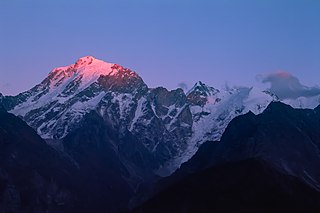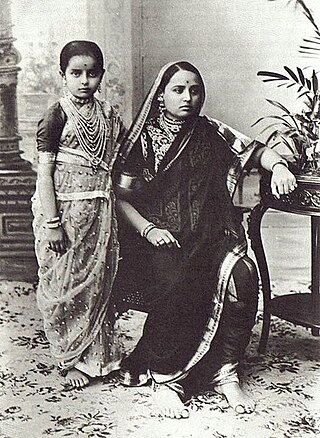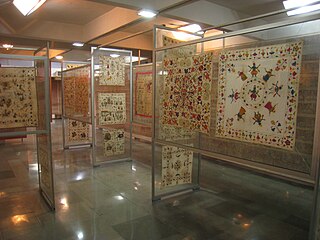
Himachal Pradesh is a state in the northern part of India. Situated in the Western Himalayas, it is one of the thirteen mountain states and is characterized by an extreme landscape featuring several peaks and extensive river systems. Himachal Pradesh is the northernmost state of India and shares borders with the union territories of Jammu and Kashmir and Ladakh to the north, and the states of Punjab to the west, Haryana to the southwest, Uttarakhand to the southeast and a very narrow border with Uttar Pradesh to the south. The state also shares an international border to the east with the Tibet Autonomous Region in China. Himachal Pradesh is also known as Dev Bhoomi, meaning 'Land of Gods' and Veer Bhoomi which means 'Land of the Brave'.

Berlin wool work is a style of embroidery similar to today's needlepoint that was particularly popular in Europe and America from 1804 to 1875. It is typically executed with wool yarn on canvas, worked in a single stitch such as cross stitch or tent stitch, although Beeton's book of Needlework (1870) describes 15 different stitches for use in Berlin work. It was traditionally stitched in many colours and hues, producing intricate three-dimensional looks by careful shading. Silk or beads were frequently used as highlights. The design of such embroidery was made possible by the great progress made in dyeing, initially with new mordants and chemical dyes, followed in 1856, especially by the discovery of aniline dyes, which produced bright colors.

Paisley or paisley pattern is an ornamental textile design using the boteh or buta, a teardrop-shaped motif with a curved upper end. Of Persian origin, paisley designs became popular in the West in the 18th and 19th centuries, following imports of post-Mughal Empire versions of the design from India, especially in the form of Kashmir shawls, and were then replicated locally.

A sari is a women's garment from the Indian subcontinent, that consists of an un-stitched stretch of woven fabric arranged over the body as a robe, with one end attached to the waist, while the other end rests over one shoulder as a stole (shawl), sometimes baring a part of the midriff. It may vary from 4.1 to 8.2 metres in length, and 60 to 120 centimetres in breadth, and is form of ethnic wear in India, Pakistan, Bangladesh, Sri Lanka, and Nepal. There are various names and styles of sari manufacture and draping, the most common being the Nivi style. The sari is worn with a fitted bodice also called a choli and a petticoat called ghagra, parkar, or ul-pavadai. It remains fashionable in the Indian Subcontinent today.

Kullu is a district in Himachal Pradesh, India. It borders Shimla district to the south, Mandi and Kangra districts to the west, and the Lahaul and Spiti district to the north and east. The largest valley in this mountainous district is the Kullu Valley. The Kullu valley follows the course of the Beas River, and ranges from an elevation of 833m above sea level at Aut to 3330m above sea level at the Atal Tunnel South Portal, below the Rohtang Pass. The town of Kullu, or simply Kullu, located on the right side of the Beas River, serves as the administrative headquarters of the Kullu district. The Kullu district also incorporates several riverine tributary valleys of the Beas, including those of the Parvati, Sainj, and Tirthan rivers, and thus some regions somewhat distant from the Kullu valley. The economy of the district relies mainly on horticulture, agriculture, tourism, and traditional handicrafts.

A shawl is a simple item of clothing, loosely worn over the shoulders, upper body and arms, and sometimes also over the head. It is usually a rectangular or square piece of cloth, which is often folded to make a triangle, but can also be triangular in shape. Other shapes include oblong shawls. It is associated with the inhabitants of the northern Indian subcontinent—particularly Kashmir and Punjab—and Central Asia, but can be found in many other parts of the world.

Phulkari refers to the folk embroidery of the Punjab. Although Phulkari means floral work, the designs include not only flowers but also cover motifs and geometrical shapes. The main characteristics of Phulkari embroidery are use of darn stitch on the wrong side of coarse cotton cloth with coloured silken thread. Punjabi women create innumerable alluring and interesting designs and patterns by their skilful manipulation of the darn stitch. According to Kehal (2009), a cloth where only a few flowers are embroidered is called a Phulkari. The other types are distinct varieties. The traditional varieties of Phulkaris are large items of cloth and include Chope, Tilpatr, Neelak and Bagh. Sometimes, the Bagh is given separate categorization of its own as on other varieties of a Phulkari, parts of the cloth is visible, whereas in a Bagh, the embroidery covers the entire garment so that the base cloth is not visible. Further, in contemporary modern designs, simple and sparsely embroidered dupattas, odhinis, and shawls, made for everyday use, are referred to as phulkaris, whereas clothing items that cover the entire body, made for special and ceremonial occasions such as weddings are called baghs. The Phulkari continues to be an integral part of Punjabi weddings to the present day.

Serbian traditional clothing, also called as Serbian national costume or Serbian dress, refers to the traditional clothing worn by Serbs living in Serbia, Croatia, Bosnia and Herzegovina, Montenegro, and the extended Serbian diaspora communities in Austria, Australia, Bulgaria, Canada, France, Germany, Greece, Hungary, North Macedonia, Romania, Russia, Slovenia, United States, etc. Like any traditional dress of a nation or culture, it has been lost to the advent of urbanization, industrialization, and the growing market of international clothing trends. The wide range of regional folk costumes show influence from historical Austrian, Hungarian, German, Italian, and Ottoman Turkish presence. Nonetheless, the costumes are still a pinnacle part of Serbian folk culture. From the 19th century and onwards, Serbs have adopted western-styled clothing. This change has started in larger settlements such as cities and towns, although it was not uncommon to see rural women in traditional working costumes all the way until the end of President Josip Broz Tito's term. Today, these national costumes are only worn by some elderly in rural areas but are most often worn with connection to special events and celebrations, mostly at ethnic festivals, religious and national holidays, weddings, tourist attractions, and by dancing groups who dance the traditional Serbian kolo, or circle dance.

Embroidery in India includes dozens of embroidery styles that vary by region and clothing styles. Designs in Indian embroidery are formed on the basis of the texture and the design of the fabric and the stitch. The dot and the alternate dot, the circle, the square, the triangle, and permutations and combinations of these constitute the design.
The North Indian state of Himachal Pradesh is a state that has remained largely uninfluenced by Western culture. Himachal Pradesh is a multi-religion practising, multicultural and multilingual state. Some of the most commonly spoken languages are Hindi and the various Pahari languages. The Hindu communities residing in Himachal include the Brahmins, Rajputs, Kannets, Rathis and Kolis. There are also tribal population in the state which mainly comprise Gaddis, Kinnarms, Gujjars, Pangawals and Lahaulis.

Anatolian rug is a term of convenience, commonly used today to denote rugs and carpets woven in Anatolia and its adjacent regions. Geographically, its area of production can be compared to the territories which were historically dominated by the Ottoman Empire. It denotes a knotted, pile-woven floor or wall covering which is produced for home use, local sale, and export. Together with the flat-woven kilim, Anatolian rugs represent an essential part of the regional culture, which is officially understood as the Culture of Turkey today, and derives from the ethnic, religious and cultural pluralism of one of the most ancient centres of human civilisation.
Among arts and crafts that come out of Himachal Pradesh state in India are carpets, leather works, shawls, metalware, woodwork and paintings. Pashmina shawl is the product which is highly in demand not only in Himachal but all over the country. Colourful Himachali caps are also famous art work of the people. One tribe, Dom, is expert in manufacturing bamboo items like boxes, sofas, chairs, baskets and racks. Metalware of the state include utensils, ritualistic vessels, idols, gold and silver jewelleries.
The traditional dances of Himachal Pradesh are very complicated. These dances are a vital part of tribal life. It reflects the culture and the tradition of Himachal. Hardly any festivity there is celebrated without dancing. Dance forms such as Nati are performed all over the region.

Khmer traditional clothing refers to the traditional styles of dress worn by the Khmer people from ancient times to the present.

The golden bush robin or golden bush-robin was first discovered in 1845 by Brian Houghton Hodgson, a British naturalist.
A Pakistani rug, also known as Pakistani carpet, is a type of handmade floor-covering heavy textile traditionally made in Pakistan and is used for a wide variety of utilitarian and symbolic purposes. Rug/carpet weaving is an essential part of Pakistani culture and Pakistani art.

The sarape or jorongo is a long blanket-like shawl/cloak, often brightly colored and fringed at the ends, worn in Mexico, especially by men. The spelling of the word sarape is the accepted form in Mexico and in other Spanish-speaking countries. The term serape is for the rectangular woven blanket, though in more recent years it can also be used to refer to a very soft rectangular blanket with an opening in the middle for one's head, similar to a poncho called gabán, or jorongo in Mexico. Modern variations of some serapes are made with matching hoods for head covering. The length varies, but front and back normally reach knee height on an average person.

Croatian national costume, also called as Croatian traditional clothing or Croatian dress, refers to the traditional clothing worn by Croats living in Croatia, Bosnia and Herzegovina, Serbia, with smaller communities in Hungary, Austria, Montenegro, and Romania. Since today Croats wear Western-style clothing on a daily basis, the national costumes are most often worn with connection to special events and celebrations, mostly at ethnic festivals, religious holidays, weddings, and by dancing groups who dance the traditional Croatian kolo, or circle dance.
A Tangaliya Shawl is a handwoven, GI protected shawl and textile made by the Dangasia community in Gujarat, India.
Kinnauri Shawl is a type shawl manufactured in Kinnaur district of the Indian state Himachal Pradesh. The shawls are known for their geometric designs.














